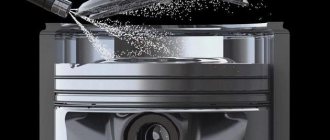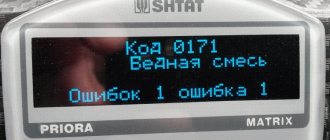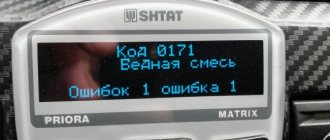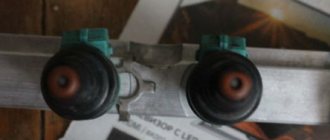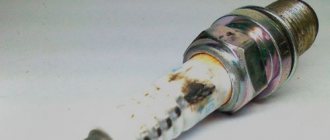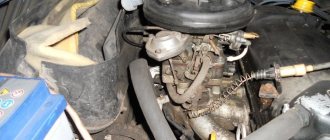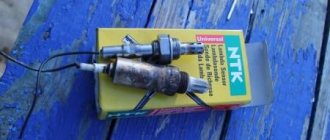Error code P0171 occurs when the mixture is too lean, when there is not enough fuel and too much air. This mixture occurs when the engine is taking in too much air from the environment and/or the fuel system is not injecting enough fuel.
This state of the mixture entails misfires, delays in the car's response to the accelerator, jerking during acceleration, idle failures, and unstable engine operation. In engine management systems Euro 2 and higher, the lambda probe controls the quality of the mixture in which there should be 14.7 parts of air per part of fuel. When the permissible range for the increased presence of air, which is 20-30% of the norm, is exceeded, error P0171 .
Injector problems
You don't have to be an expert to understand that the problem here lies in the operation of the injector. And first of all, before we start studying lean mixture, let’s try to find out what it even is. This is important only because such a reason can lead to expensive repairs to the car.
Why do jerks happen?
The presence of jerks while the car is moving is a problem that directly or indirectly indicates the presence of problems with the engine, or more precisely, a loss of power. In total, there are two features that affect the development of power in the engine - fuel supply and the ignition system.
If with the ignition, everything is more or less clear, due to the inspection of the generator, spark plugs, ignition wires for faults, and the battery for charge, then in the case of the ignition system everything looks much more complicated.
High voltage wires are marked with arrows
Inspecting the condition of the spark plugs
To ensure a successful engine start, it is necessary to mix the fuel and air mixture in ideal proportions; this is what the injector is responsible for.
It happens that when mixing these proportions, a malfunction occurs, and the mixture turns out to be rich or lean.
A clear example of the air-fuel mixture ratio.
In order for the car to obtain maximum power when burning fuel in the cylinders, it is necessary to bring its indicator to the level of 0.85 - 0.9, when excess oxygen = > 1 (at this indicator, gasoline burns completely without residue - approx.), and when there is a lack of oxygen and the reading is < 1.
The main reasons for a lean mixture
The main and most important symptom that the system has a lean mixture is a stalling or unstable engine. And if the mixture is very poor, then it is possible that it will not start at all.
The cause of these problems is most often a clogged air filter (see “replacing the air filter”), clogged injectors, wear in the fuel pump, and there may also be air leaks into the system. All these reasons are, one way or another, related to the stable operation of the engine.
What do spark plugs tell us?
One of the fundamental checks for the condition of the mixture will be to assess the condition of the spark plug.
So, a light brown tint will indicate that the system is operating normally, a too dark tint will indicate a lack of (enriched mixture - approx.), too light, an excess (depleted - approx.) mixture.
Candles with different types of soot
Please pay attention to the fact that if, in the presence of such malfunctions, the throughput decreases by at least 10-15% , this may lead to further failure of the oxygen sensor (lambda probe, if equipped - approx.), or worse, lead to increased detonation.
And this, as you can already understand, will directly affect the performance of the motor. You can change the engine performance readings by cleaning the injector (nozzles), provided the ignition elements are working correctly.
Stable washing every 20-30 thousand kilometers can keep it in close to ideal condition.
Diagnostics of the throttle valve block on a VAZ-2114
If you have never performed such a procedure, then first of all you can be advised to inspect the condition of the throttle valve for carbon deposits and other deposits, because fuel vapors coming from the intake manifold settle precisely in this place, accumulating over time.
And the already deposited carbon deposits prevent the damper from closing completely, allowing more air into the system, thereby changing the composition of the mixture - making it leaner. Since large traces of carbon deposits can be detected visually, cleaning should be done with a regular carburetor cleaner, sold in cylinders of different capacities.
We dismantle the throttle assembly
How to clean the injector yourself!
If you do not want to take your car to a specialized workshop to clean the injector, then you can handle this on your own. This work can be carried out both on the removed mechanism and directly on it.
In order to clean the injector (nozzles - approx.) on a VAZ-2114, you need to read this article and do everything as stated in the detailed instructions.
Fuel system malfunction
Other causes of a lean mixture on the injector are due to improper operation of the vehicle's fuel system. As a rule, operational disruptions occur due to low-quality fuel, which is filled at little-known gas stations. One of the options for unstable engine operation and the formation of a lean mixture is clogged fuel cells of the car. In such cases, there is a misfire in the engine. As a result, the car may jerk. To prevent this from happening, it is necessary to purchase fuel only from trusted gas stations. Both fuel elements should also be replaced in a timely manner. Remember that one filter is presented on the injector in the form of a mesh and is installed directly into the fuel pump. The second element is most often located near the tank on the bottom of the car, less often in the engine compartment. To avoid over-leaning the mixture, it is necessary to change them at least once every 40,000 km. Sometimes this figure may be lower, since it all depends on the quality of gasoline.
Causes of excess air
If, after carrying out this work, instability is also observed in the operation of the system, pay attention to possible places where excess air occurs, since it also affects the leanness of the mixture and the main reasons lie in the following:
And in order to eliminate the above reasons, it is necessary to conduct a thorough diagnosis.
Troubleshooting
Mass air flow sensor - the air flow sensor can become clogged due to natural reasons, as well as from vapors that come from the throttle valve while the car is not running. And then, over time, accumulating in a thick layer on the thin thread of the sensor, forcing it to send inaccurate data to the ECU, which in turn negatively affects the parameters of air flow and flow into the system.
When diagnosing its malfunction, it is best not to rush into purchasing, since it costs a lot of money, but it is best to check its performance on a known working device. And when it is established that the reason lies in it, then you can try to clean it, or then replace it with a new one.
Vacuum leak
Vacuum leak - these words mean any form of air leaks, that is, suction into the system, primarily through the manifold gasket or hoses.
The vacuum pump and return hose may cause
Pay attention to the condition of the pipe leading from the air filter to the throttle valve, and the hoses that go to the crankcase ventilation. There should be no visible damage to them, as well as large cracks through which excess air could enter.
In addition to all of the above, you can check the engine oil dipstick and the oil filler cap on the neck, because if these connections are not completely closed, they can cause the appearance of that same excess air.
Self-adjustment
Most drivers are very glad that they know how to adjust the throttle angle, as they are completely confident that this will help regulate fuel consumption. In addition, some resort to flashing the vehicle's electronic control unit. In order not to damage some units or ECUs, it is worth seeking help from qualified technicians who can, using special programs, without affecting the quality of the mixture, improve some of the car’s performance. Otherwise, the risk of “killing” the engine of your vehicle increases. Thus, a lean mixture is formed on the injector, the reasons (2114 is no exception) for which lie in the independent adjustment of the angles or the intervention of an inexperienced car owner in the operation of the engine system.
Error P0171 - what it means, symptoms, causes, diagnosis, solution
This article will tell you everything you need to know about the P0171 code. You will also learn how to diagnose and fix the error yourself in the easiest and fastest way.
There is a lot of misinformation about the P0171 code and a lot of dubious advice on how to fix it. In this article, we will tell you how to properly diagnose this error code in order to find solutions as quickly as possible.
FakeHeader
Comments 13
systematic error or one-time error?
Well then it was a really poor mixture. Have you checked the valves? My OMVL ones turned out to be surprisingly shit, unlike the valves from Digitronic
no, why? it works fine
yes the topic with floating speed on gasoline www.drive2.ru/l/5124397/ it was from them
I remember I remember. so far the flight is normal
There was such a mistake, the pressure on the reducer was 'corrected' and everything was ok.
It shouldn’t. The gas supply has been adjusted. A friend at work has a scanner. I’ve been driving without errors for a couple of weeks now
What does error code P0171 mean?
P0171 is triggered when the front oxygen sensor detects a lean mixture. This can be either a short-term or a permanent lean mixture.
The front oxygen sensors regulate the fuel mixture that leaves the engine. If the oxygen sensor detects a slight lean or rich mixture, it sends a signal to the engine control unit to adjust the mixture in the next combustion cycle to obtain the ideal fuel mixture for better fuel economy.
Oxygen sensors typically have a range of +/- 15% to adjust the fuel mixture.
If the fuel mixture is outside this range, the O2 sensor will not be able to adjust the mixture. The engine control unit (ECU) will initiate and store a fault code in memory. If the mixture is lean, error code P0171 will be triggered.
If the mixture is rich, then you will have a P0172 code. If you have a V-twin engine or two O2 sensors, you may also see a P0174 code, which means the mixture is also lean, but on the second cylinder bank.
Video "Lean mixture"
Error code P0171 occurs when the mixture is too lean, when there is not enough fuel and too much air. This mixture occurs when the engine is taking in too much air from the environment and/or the fuel system is not injecting enough fuel. This state of the mixture entails misfires, delays in the car’s response to the accelerator, jerking during acceleration, dips in idle, and unstable engine operation. In engine management systems Euro 2 and higher, the lambda probe controls the quality of the mixture in which there should be 14.7 parts of air per part of fuel. When the permissible range for increased air presence is exceeded, which is 20-30% of the norm, error P0171 appears.
How to diagnose P0171?
Since the P0171 trouble code means the vehicle is running lean, it can be caused by many different sensors or faulty parts.
This guide is about how to fix the P0171 code the fastest way and what an experienced mechanic will do to find the problem. When performing these steps, you may need some tools to quickly and effectively troubleshoot problems. But you can do without them, try following the instructions.
1. Connect the charger to the car
The first step you should always take when diagnosing a car. You will often turn on the ignition while troubleshooting, and the vehicle voltage should not be low.
Low voltage may cause other unrelated trouble codes. In rare cases, low voltage can even damage electronics, so always use a charger when diagnosing.
2. Check all sensor parameters using an OBD2 scanner
If you have an OBD2 scanner, you can check all sensor parameters. Just check the values of the MAF, coolant temperature, boost pressure, intake temperature sensors and make sure the values are correct.
Many scanners have tables of base values that should be displayed at certain speeds and temperatures. Also, check the oxygen sensor parameters and make sure they are correct. Replace faulty sensors, clear error codes and try again.
You can also do it the old fashioned way and measure all the sensors with a multimeter. This will take a very long time and you have to find which values are correct. If possible, we always recommend using an OBD2 scanner.
3. Check for other fault codes
If you have measured all sensor parameters and are satisfied that they are correct, check for other stored and associated fault codes in the controller. They can tell you where to start your search.
Many problems with sensors occur periodically. When you check them, you get normal parameters, but while driving they may not work correctly and cause a P0171 code.
The control unit is smart. It recognizes the faulty value in just a second and this triggers a fault code. These are the trouble codes you should be looking for. If you receive another error code from any sensor, you need to start checking with the corresponding part of the car first. This can save a lot of time.
Check for inlet leaks
Air leaks are a common problem when it comes to the P0171 code. Leaks in the intake manifold/vacuum hoses/turbocharger can fool the MAF sensor and cause the mixture to lean.
The mass air flow sensor measures all the air entering the engine and reports this amount to the controller. The ECU then injects fuel into the engine depending on the amount of air. A leak can distort this value, resulting in a lean mixture.
The easiest way to find a leak is to use a smoke generator. They, unfortunately, are quite expensive for the car enthusiast. You can make a smoke generator yourself.
Video on how to find air leaks at home without a smoke generator:
And one more piece of advice. You can use a flammable spray like Quick Start or brake cleaner. Spray around the intake while the engine is idling. If the RPM increases, there is a leak in the spray area. For the same purposes, you can use a soap solution.
An air leak can often be found in the PCV valve, especially on VAG vehicles such as Audi, Volkswagen, Seat and Skoda. If you have one of these cars, check the PCV valve under the intake manifold or on top of the engine on newer 2-liter engines.
PCV valve
You should also check the EVAP valve, which controls fuel gases. A leaky or faulty EVAP valve can cause a lean mixture. You can test this valve by blowing through it to see if it is closed or not when it should be.
The problem often occurs in the hose between the intake manifold and the fuel pressure regulator. This causes low fuel pressure and sets the P0171 code.
Check fuel pressure
Low fuel pressure is a common occurrence with the P0171 code. Troubleshooting this problem can be quite difficult because you often check the fuel pressure only at idle. Low blood pressure can occur in other situations. This is usually solved by connecting a pressure gauge.
Many cars have a fuel pressure sensor that allows you to monitor the pressure while driving. But the problem is that this sensor may also be faulty. In this case, the controller will show a low fuel pressure error.
In any case, you need to check the fuel pressure at idle. This may indicate a faulty fuel pump or fuel filter. To check, you will need to connect a pressure gauge to the fuel line.
You should find out what pressure your car has. Disconnect the vacuum hose between the intake manifold and the fuel pressure regulator to obtain the correct value. You can ask a partner to rev the engine to see if the fuel pressure drops.
6. EGR check valve
An open EGR valve when it should be closed can fool the air flow sensor and cause a lean mixture. Checking the EGR valve can be a challenging task. This usually requires removing it or using a smoke generator.
Many OBD2 scanners have an electronic EGR test function. They check the air entering the engine as it opens and closes. This can often help locate a faulty EGR valve because the test will give a positive or negative result.
The ECU often recognizes faulty EGR valves and stores a fault code stored in the controller's memory, but not in all cases. So it's better to double check it. Faulty EGR valves causing P0171 are common on Opel engines. Clogged EGR lines on Opel engines can also cause this.
Here is a video on how to check the EGR valve:
Checking air leaks at the outlet
Air leaking into the exhaust system in front of the oxygen sensors can fool them and cause code P0171. To check for this, the easiest way is to start the engine and listen carefully for any leaks in front of the O2 sensors.
You can have someone plug the exhaust pipe to create pressure in the exhaust system. If you have a smoke generator, everything is even easier. Simply connect it to the rear exhaust pipe and check for smoke from potential leak areas.
It could also be the oxygen sensor that is causing the P0171 code, but this is something you should have already checked in the previous diagnostic steps.
Clogged injectors
If you do not change the fuel elements of the car system on time, a lean mixture may form on the injector, the reasons for which will lie in the incorrect operation of the injectors. That is, fuel is supplied, but supplied in fairly low quantities. An injector is a special device related to the injection system of a car. There are many elements: electromagnetic, electrohydraulic or piezohydraulic. Vehicles with gasoline engines use electromagnetic parts.
To solve the problem, you can restore the previous injection by washing the injectors, which is carried out only using special equipment.
By the way, to avoid contamination of fuel filters and injectors, you should clean the fuel tank at regular intervals, since there is a large accumulation of dirt, sand or other substances there.
